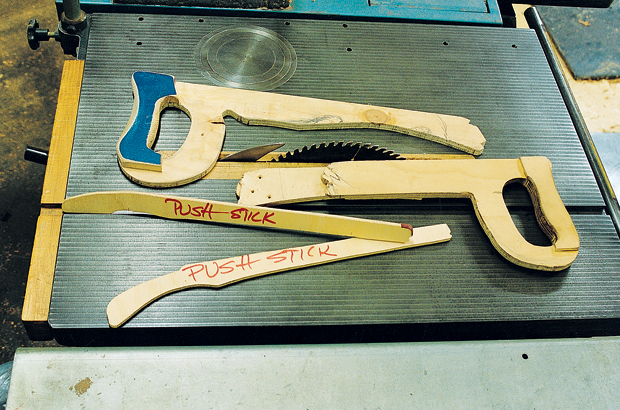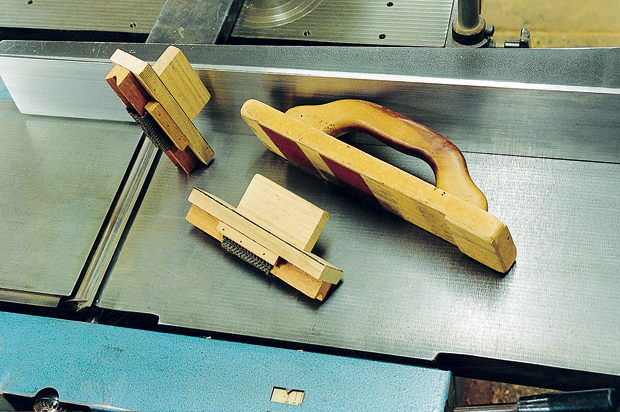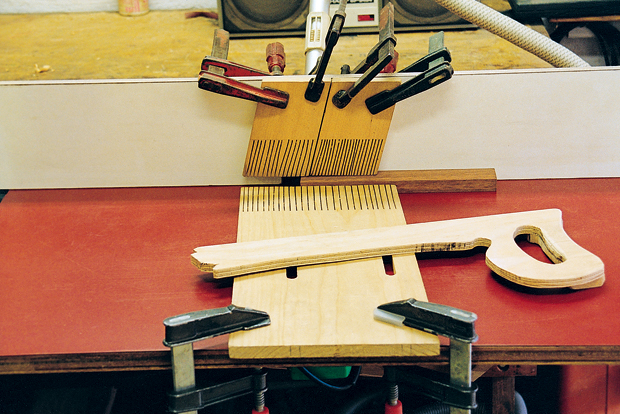Words and photos by Richard Vaughan
There is no sound as loud as that of your own flesh and bone being mangled. And it lasts much longer than the heart jolting whack of a push stick catching on fast sharp steel.
The longer you practise woodwork the greater your chances are of damaging the incredibly subtle tools which are your hands. Keeping your fingers at a respectful distance from the cutting edge is a simple way of reducing the risk. It’s healthy to be paranoid around woodworking machinery.
Saw Not Sore
Push sticks are easy to make and worth making well. And while you’re at it, make enough sticks so that no machine in your workshop is without its own. Plywood is a safer option than timber because it won’t split the way wood can at the impact of a sawblade. 10 or 12mm ply shaped as in the photo below is sturdy, and enclosed handles give protection in the event of a slip which could glance exposed fingers into the sawblade. Gluing extra ply on the handle and shaping it for comfort enhances the grip.

In time the pushing end will get chewed down and renotched till it’s past the comfort zone. But remember: each chunk out of the push stick is a chunk that didn’t come out of you. The stick can be extended again simply by gluing another length of ply as has been done with one of the sticks shown above.

When using the tablesaw to rip wood, two sticks are certainly safer than one as shown above where the side push stick is guiding the workpiece by keeping it firmly against the fence. The pressure is before the cut so the waste is not being pushed against the blade. Note also how the fence ends just past the middle of the blade to minimise the chance of spring in the cut wood jamming it against the blade. The riving knife or splitter is of course essential so the cut can’t close onto the saw. Keeping the splitter smooth and clean with a nylon scouring pad and paraffin wax reduces friction.
Despite these precautions the wood can sometimes grab and be speared back out. You can see I'm standing to the side rather than directly behind for this reason.
There are times when a skinny push stick is appropriate, hence the slimmer versions in 6mm ply shown in the photo. When pushing thin or small bits of wood it can be more effective to use a push stick with sandpaper glued to its end rather than a notch. I mark them as ‘push sticks’ as it's less likely they’ll be thrown out in a cleanup.
Dress Wood, Not Wounds
Pushing wood over the jointer generally requires pretty firm pressure so you need a sturdy pusher as the tail end of the wood goes over the knives. I made the version in the photo below but you could adapt a plasterer’s wooden float as long as you’ve made certain that the handle is very securely attached and there is no metal underneath which would damage your jointer knives.
Please note in the photo below the guard was removed for photo visibility and the saw was stationary.

For this pusher I recommend straight grained hardwood because the glue in ply is rough on high speed steel jointer knives. Under the back end glue (don’t screw or nail!) a 6mm block of wood with the grain direction matching that of the body for a surer glue bond. Gluing sandpaper on the undersurface helps grip on the timber being jointed.
The two little pushers in the photo are the ones I should have been using several years ago. Near the end of a long day I wanted to take just one light pass over the jointer from a slender fillet of wood. After almost 20 years of woodworking I was excruciatingly stupid, didn’t get the pushers and paid for my folly with the top joint of my finger. (No, that’s not why it’s called a jointer.)
If you do have to put small section of wood over the jointer these little pushers work nicely but you could easily make them a bit larger and even safer. The grip of the V-shaped groove is enhanced by strips of that sticky mat product that no workshop should be without.
Wooden Fingers
The router table is another hazard zone which is worth making safer. Featherboards are simple to make and very effective. A series of 70mm long saw kerfs about 4 or 5mm apart are cut in pieces of straight-grained wood so they look a bit like combs. When these are clamped to the fence and table in firm contact with the piece to be fed over the router they make the workpiece track true and they stop it kicking back. Even more importantly, they go over that whirling router bit making accidental finger contact with it less likely. And of course you’ll have a push stick handy to push the end through.

Woodworking does involve some danger as we all know, but making and habitually using effective push sticks reduces the risk. I assure you that for this woodworker there was and is no sense of ‘badge of honour’ about losing a finger tip, just feelings of stupidity, pain and loss. You take care of yourself, eh.
Richard Vaughan is a furniture designer/maker in Brisbane and also teaches woodwork classes. Learn more about Richard here.







